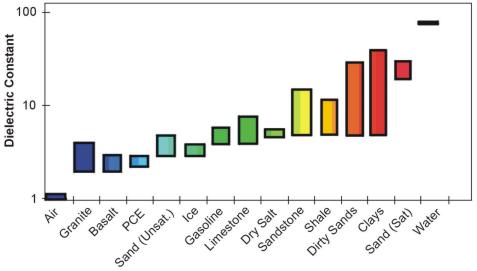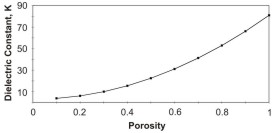Dielectric Permittivity
Dielectric permittivity relates charge separation to an applied electric field. That is, materials with no ions or electrons (i.e., free charges) may transmit electrical current when a voltage is applied. Dielectric permittivity describes the charge displacement in these materials when a voltage potential is applied.
This mobile charge is bound to the molecules of the material (e.g., the positive charge on the nucleus and the negative electrons of the electron shells). An applied electrical field polarizes this charge distribution and separates the positive and negative charges in the opposite direction. Figure 1 shows a schematic result of applying an electric field to a molecule.
Figure 1. Schematic displacement of charge within a molecule by an electric field, E.

Permittivity is sometimes expressed relative to the permittivity of free space, εo , and in terms of the dielectric constant κ (although it is not that constant).
ε = κ εo
Figure 2, below, displays the range of the dielectric constant for different materials including air (κ = 1) and water (κ = 80). As such, the constant is not constant; but is a range of values.

Figure 2. Dielectric constant range for some common materials.
Water ( κ = 80) clearly dominates the permittivity of any rock- or sediment- water mixtures and is a function of porosity of the rock or sediment (Fig 3).

Figure 3. Dielectric constant of a water-saturated rock as a function of porosity (κ = 81; κ = 3) (Calvert, 1987).
Permittivity is the primary factor influencing the speed of electromagnetic radiation in earth materials at GPR frequencies. A contrast in GPR velocity, which would be due to κ contrast, would then produce reflections of electromagnetic energy within the Earth. As a result, κ is the major influence on ground penetrating radar measurements. Additionally, κ is strongly frequency dependent in parts of the electromagnetic frequency spectrum and is considered only at ground penetrating radar (GPR) frequencies, in the range 100 to 1,000 MHz. These relationships are shown below.
The velocity, V, of electromagnetic waves through a medium of permittivity ε and magnetic permeability μ is:
V = (μκ)-1/2
The reflection coefficient is, R, the ratio of the reflected to incident EM signal amplitude for an EM signal traveling from medium 1 towards medium 2 (i.e., a contrasting permittivity) is:
R = (κ11/2 - κ21/2) / (κ11/2 + κ21/2)
